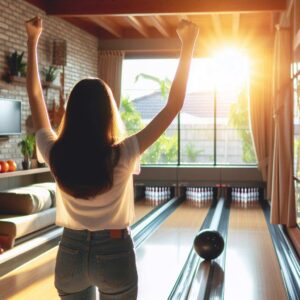For many bowling enthusiasts, those dusty, discolored balls tucked away in the basement or attic are more than just relics of the past. They’re nostalgic pieces of history, reminders of bowling’s golden age and the evolution of the sport over decades. But beyond sentimental value, the question remains: are old bowling balls worth anything in terms of monetary value? The answer, as with many collectibles, depends on a variety of factors. While common old balls may fetch little more than a few dollars, rare and highly collectible vintage bowling balls can be worth a surprising amount to avid collectors. In this comprehensive guide, we’ll explore what makes an old bowling ball valuable, how to identify and evaluate them, and tips for those looking to buy, sell or simply appreciate these unique pieces of sports history.
Factors That Affect Value of Old Bowling Balls Age:
The first factor in assessing an old bowling ball’s worth is its age. In general, older bowling balls pre-dating the 1960s tend to be more collectible and valuable, especially those made of wood or rubber. However, age alone doesn’t guarantee value – other characteristics come into play.
Manufacturer:
Certain manufacturers and brands are highly coveted by collectors. Brunswick, AMF (American Machine and Foundry), Ebonite, and Track are among the most desirable and recognizable vintage bowling ball makers. Limited edition or commemorative releases from major brands can also fetch premium prices.
Rarity:
As with any collectible, scarcity equals value when it comes to vintage bowling balls. Rare, limited production runs or balls no longer manufactured are prime targets for collectors willing to pay top dollar. For example, the ultra-rare Pyramid Bowling Ball Company’s “Blue Coral” design can sell for thousands due to its extreme limited availability.
Condition:
An old bowling ball’s condition is a huge factor in its value. “Mint” or “near mint” balls with little to no damage or wear are the most valuable. Any cracks, chips, gouges or deformities will significantly diminish a ball’s worth. Things like the surface condition, whether it’s been resurfaced or plugged (holes redrilled), markings and original components/inserts all play a role.
Historical Significance:
Bowling balls previously owned or used by famous professional bowlers often hold immense value thanks to their provenance and connection to bowling history. Commemorative balls from tournaments, organizations or significant events are also highly prized.
Popular Materials Used in Vintage Bowling Balls Wood/Hardwood Balls: Some of the earliest and most antiquated bowling balls were constructed from solid wood or hardwood like maple or oak. These can be valuable despite often having a plain, unfinished appearance due to their historical significance and rarity, with some dating back to the 19th century. The oldest can sell for $300 or more in good condition.
Rubber Bowling Balls:
As materials evolved, rubber became a popular choice around the early 1900s up until the 1960s or so. Well-kept examples in their original box can easily fetch $100-$300+ depending on the brand, specific rubber compound used, and condition.
Polyester/Plastic Bowling Balls:
By the 1970s and 80s, cheaper plastic materials like polyester started replacing rubber as a more affordable bowling ball material. While these tend to have lower values, prized vintage polyester models from top makers can still sell for $50-$100+ in great shape.
Reactive Resin Balls:
More modern bowling balls (1990s-2000s) were constructed from reactive resin materials to allow for more hook potential and have a grippier surface. While most reactives from this era don’t carry much value yet, some rare limited edition resin balls from that transitional period are starting to gain collectors’ interest.
Most Valuable Vintage Bowling Ball Brands/Models Brunswick Ninji/McVerigh Series:
Produced from the 1920s-1960s, the iconic Brunswick Ninji and McVerigh rubber bowling balls are some of the most prized, with pristine examples selling for upwards of $500-$1000.
Brunswick Siris/Proline Series:
Other valuable Brunswick vintage ball lines from the 40s-70s include the Siris rubber balls ($200-$500+) and polyester Proline balls ($100-$300).
AMF Bowling Balls:
As a titan of 20th century bowling manufacturing, AMF produced many desirable vintage rubber and polyester balls from the 50s-80s like the AMFRelief, Pulled Delrin, Trophy Tomahawk and others routinely selling for $100-$400+ in great shape. The AMFlite lines of rubber balls are especially valuable.
Ebonite/EBI Game Balls:
Coveted by collectors are rubber balls like the Ebonite Blue Streak, Golden Nugget and Crystalac, which can fetch $300-$800+ for well-maintained vintage pieces. The EBI Game Ball rubber balls from the 40s-60s also have a very loyal following.
Track Bowling Ball Company Classics:
This long-running bowling brand produced many vintage rubber and polyester balls of note like the Track Ruby Line, Jade Jewel and Rock maple series ($100-$500+ range).
Grading/Evaluating Condition of Vintage Bowling Balls
When it comes to assessing an old ball’s value, condition is paramount. Here’s a quick rundown on typical grading terminology:
Mint/Near Mint: As close to perfect as it gets – ball has zero flaws, no damage, original components/finish intact as from factory. One of the highest graded conditions for top value.
Excellent: Only very minor, almost imperceptible signs of use but overall pristine condition with original components.
Very Good: Light, scattered surface marks/scratches but no major gouges or chips. All components intact.
Good: Moderate signs of use/wear but no major structural damage. Some light oxidation may be present.
Fair/Poor: Significant wear, major blemishes, gouges or damage present. Missing components. Only valuble if very rare model.
Grading serves as an objective way to assess a ball’s worth, but condition is judged holistically on everything from surface flaws to internal components to provenance/paperwork included.
Where to Buy/Sell Old Bowling Balls If you have some old bowling balls sitting around, where’s the best place to sell them? Or if you’re a budding collector, where can you track down those elusive vintage gems?
Online Mark etplaces:
Sites like eBay are a natural first stop, allowing sellers to connect with worldwide buyers. Facebook groups and bowling enthusiast forums are other online options to buy, sell and trade. Do thorough research on accurate pricing and grading before listing.
Local Bowling Alleys/Pro Shops:
It’s definitely worth stopping by any bowling alleys or pro shops in your area, as they may take vintage ball trade-ins or know of collectors buying/selling locally.
Collectors Shows/Conventions:
For serious collectors and sellers, bowling conventions, memorabilia shows or collectibles expos can be a goldmine for vintage ball finds. Expect avid interest and premium pricing at these niche events.
Antique Stores:
Check with local antique malls, flea markets or shops – you never know when a rare vintage ball may surface. These venues are more hit-or-miss but can yield hidden gems.
Displaying/Storing Vintage Bowling Balls If you’re lucky enough to own some valuable antique bowling balls, you’ll want to take great care in properly storing and displaying them. A few tips:
Display Shelves/Racks:
Quality wood or metal display shelves allow you to proudly showcase your prized vintage balls out of direct sunlight. Clear acrylic racks offer protection while allowing 360 viewing.
Climate-Controlled Storage:
Basements, garages and attics are not ideal long-term storage spots due to fluctuating humidity/temperature. A climate-controlled environment like an interior closet minimizes degradation.
Handling With Care:
Avoid directly handling vintage balls more than necessary and never toss or roll them around. Use soft cloths or gloves to prevent transferring body oils and acids which can damage materials over time.
Restoring/Resurfacing Antique Bowling Balls As collectibles age, the question of whether to restore or resurface them inevitably arises. This is a nuanced, often hotly-debated topic in the vintage community.
Professional Resurfacing:
For extremely valuable balls showing signs of deterioration, professional resurfacing may be worth the cost to halt further damage. Experts completely strip off old coatings and seamlessly reapply protective finishes. This process is recommended for particularly rare, irreplaceable models.
At-Home Restoration Techniques:
Some collectors attempt light DIY restoration, like carefully removing surface scratches and oxidation with specialized polishing compounds. However, this requires immense care and research to avoid doing unintended damage. Gentle soap/water cleaning is generally safer for basic upkeep.
When to Avoid Restoration:
For the most part, the purist collector mindset is to avoid any restoration or resurfacing processes that alter the ball’s original state. This preserves the authenticity and integrity. Unless absolutely necessary to prevent deterioration, many opt to keep vintage bowling balls “as-is” with all their natural age characteristics and patina intact.
Bowling Ball Collector Tips
Research Beforehand: Before purchasing any vintage bowling balls, especially expensive ones, research the specific ball extensively. Cross-reference details across credible collector resources and sales records to verify authenticity and fair market prices.
Verify Authenticity/Provenance: Particularly with any supposed “pro-player” or commemorative releases, insist on clear documentation of the ball’s origins and chain of possession. Things like original packaging/paperwork, dated tournament stickers, photographs, etc. help prove legitimacy.
Understand Values & Pricing: Study up on accurate pricing guides and sale results for the models/brands you’re interested in. Factor in both optimistic seller pricing and actual realized sale prices to find a fair market value range. Conditions grades also greatly impact price.
Join Collector Communities: There are abundant online forums and clubs for vintage bowling ball collectors to join. This allows you to converse with experienced collectors, find trusted buyers/sellers, get advice, and stay looped into the latest news and developments.
Conclusion
While most old bowling balls gathering dust in basements and attics likely don’t carry much monetary value beyond sentimental attachment, there are indeed vintage gems out there quite valuable to diligent collectors. As this guide illustrates, factors like manufacturer, materials, rarity, condition and historical significance can mean the difference between a worthless relic and a prized piece of bowling history worth top dollar.
For those simply looking to offload some old balls, a little bit of research into the brands, approximate age and state can reveal whether they might pique collector interest. With some due diligence, you could potentially turn those nostalgia-inducing orbs into a nice cash windfall.
If you’re keen to start or expand a vintage bowling ball collection, the keys are developing a keen, trained eye for authenticating balls and understanding actual market values. Joining collector communities and frequently buying/selling in reputable marketplaces is also wise. While costly mistakes can happen with overpriced, misrepresented balls, an astute hobbyist can assemble an impressive display of bowling’s material heritage.
At the end of the day, though, the true value and joy in collecting vintage bowling balls often transcends mere monetary worth. These relics connect us to the sports’ origins, preserve its legacy, and evoke wistful memories of our cultural bowling experiences over generations. For many collectors, that sentimental, passionate drive simply can’t be measured in dollars.





